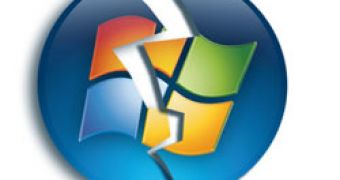Windows Vista Ultimate, Enterprise, Business, Home Premium and Home Basic have all been cracked and are available as free downloads from peer-to-peer networks or for sums lower than $10 on street-shops. Sounds like a bargain, right?
But the fact of the matter is that the saying "the best things in life are free" simply does not apply to software, and certainly not to Windows Vista. November 30, 2006 when the business version of operating system was made available to Microsoft's Software Assurance customers via volume licensing marked the start of the Windows Vista Crack fiesta.
Initially, spoofed KMS servers emerged on the Internet designed to provide a workaround for activating Windows Vista Enterprise. Microsoft confirmed and then took action against the Vista Frankenbuild crack by updating the Windows Genuine Advantage mechanism in order to render inoperable copies of the operating system activated with RC files. Following what the Genuine Advantage team has affectionately nick-named the Frankenbuild monster, Microsoft acknowledged the existence of the 2099 Crack.
Since early January, the 2099 Crack, also known as the Time Crack, TimerCrack, TimerStop or TimerStopper is still active. Microsoft is working on a WGA update but it is still unknown when the workaround will be tackled.
And there are other examples and options for illegally circumventing the Windows Vista activation process. And they are all free, or come with the promise of no charge at all, when in fact the reality offers a different perspective altogether.
The main hidden cost of Free is the fact that users will be transformed into victims. It is an invisible price tag that does take its toll. Just because there is no monetary value associated with the Windows Vista cracks or that there is no financial transaction doesn't mean that users deploying such workarounds won't be paying through their teeth.
The bottom line is that Windows Vista is not immune to malware. Not even by far. In fact, malicious code already in existence can successfully compromise Windows Vista. And attacks are no longer destructive. Cracks camouflaging malicious code are part of a strategy of social engineering designed to get users to download and execute files on their machines, effectively handing over their computers.
There are two different vectors of attack. First off, cracks represent a security risk due to the fact that the architecture of the operating system is malformed, cutting Windows Vista from the Microsoft updates. In a manner similar to its predecessors, Windows Vista is not foolproof and will require security updates. An unpatched operating system, even Windows Vista, is vulnerable to exploits.
In this regard, recently hackers have made available a crack cocktail (goes well with the Windows Vista crack fiesta), a combination of the Key Management Server and Frankenbuild workarounds. The main advice that comes with the crack is not to install any Microsoft security updates. Vista copies activated with this workaround will perpetually be vulnerable.
Another avenue of attacks is represented by the cracks themselves. Toward the end of January, security company DriveSentry warned that no less than half of the free downloads for Windows Vista were crawling with malware. Free did you say? Where?
Free Windows Vista is not only worthless to users but comes with a price tag that is larger than the actual value of the genuine operating system. Losing confidential information, having your data hijacked and consuming bandwidth to fuel DoS attacks and spamming campaigns because the computer has become part of a botnet are "expenses" that I know I don't afford... How about you?

 14 DAY TRIAL //
14 DAY TRIAL //